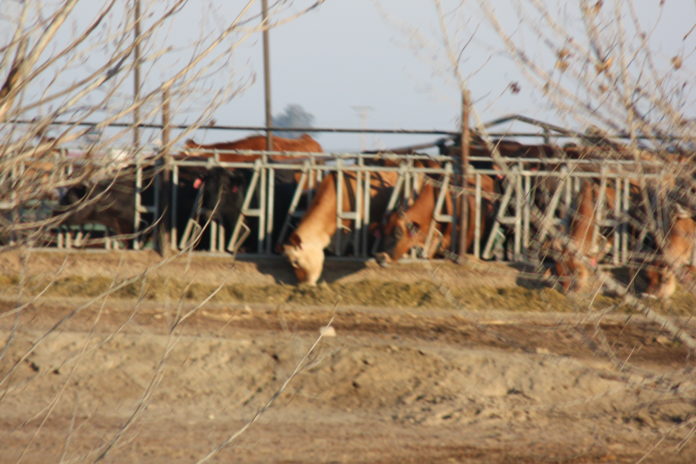[player id=11433]
 The Tulare Irrigation District held its board of directors meeting on Tuesday, October 13, 2020 remotely from its Tulare County headquarters using Webex. While waiting for the meeting to begin General Manager Aaron Fukuda said a refinance team will be joining in at 10:30AM. Chairman David Bixler called the meeting to order at 9:00am. There was no public comments and the minutes were approved.
The Tulare Irrigation District held its board of directors meeting on Tuesday, October 13, 2020 remotely from its Tulare County headquarters using Webex. While waiting for the meeting to begin General Manager Aaron Fukuda said a refinance team will be joining in at 10:30AM. Chairman David Bixler called the meeting to order at 9:00am. There was no public comments and the minutes were approved.
Water Report
TID Water Master Marco Crenshaw was the first to give a report saying – nothing because his microphone wouldn’t unmute. He had to go to Fukuda’s office to report. Webex isn’t the most reliable system. Zoom seems to be the best for meetings. Crenshaw moved to Fukuda’s office and we could hear him. He said Lake Kaweah is low, inflow is low and not much happening. Millerton Lake’s data hasn’t been updated this month. Inflow in  September was very low due to the Creek Fire. The upstream reservoirs were set to low flow and evacuated. This caused a shortage requiring prorated deliveries on the Friant Kern Canal. The inflow returned to normal and the FKC is planned to shut down in mid-November. The Creek Fire has burned more than a quarter of the entire San Joaquin River watershed. Crenshaw said the fire could cause a great deal of sedimentation to run downhill.
September was very low due to the Creek Fire. The upstream reservoirs were set to low flow and evacuated. This caused a shortage requiring prorated deliveries on the Friant Kern Canal. The inflow returned to normal and the FKC is planned to shut down in mid-November. The Creek Fire has burned more than a quarter of the entire San Joaquin River watershed. Crenshaw said the fire could cause a great deal of sedimentation to run downhill.
A fire in the Tule River watershed has spread into the southern part of the Kaweah River watershed. It is slow moving and there is precedent from the late 1800s where sediment dammed creeks which burst during a very wet year.
Moving from fire to the oceans Crenshaw showed a slide of the Pacific Ocean water temperatures. The “Blob” has returned. A warm section of the ocean settles of the west coast of North America that some how impacts the storm patterns sending them either north or south of California. There are also El Nino and La Nina weather years and Crenshaw said the correlation to how much precipitation is received doesn’t really provide a reliable indicator. The Blob is much more consistent in weather forecasting. Things look like a dry winter is shaping up.
Crenshaw continued saying deliveries to the City of Visalia has shut down for maintenance and will start up again once that’s completed.
Superintendents Report
Superintendent Wayne Fox gave his report showing progress on the district’s ditch system. He put up a map of the canals color coded by what tasks have been completed such as: mowing and grading. He believes the schedule is on course for completion by the end of the year. He praised his crews for working hard and getting things finished. Fukuda pointed out how efficient Fox and his crew have been.
Fox said there has been ongoing tailgate meetings for safety. There was even CPR training. Good for them. He said turnout repairs, gates, frames and screens are about 80 percent completed. Fukuda said in years past the district had to rent equipment to meet the schedule but this year the guys have been knocking it out of the park. Most of this was part of the Third Quarter O&M report which was approved by the board.
Finances
Controller Kathi Artis gave her report reviewing the statements. The assets minus liabilities equaled $36 million in equity. Interest rates are dropping with the Tulare County investment pool between two and three percent. There were no questions and Artis continued with the payables. Everything was in order so the board agreed to pay its bills. Director Dave Martin asked how much legal advertising is costing TID. Fukuda said they have to use an adjudicated newspaper to post delinquent assessment notices. The district  filed 75 last year. He’d like to use the Sun Foothill Gazette, a fine publication by the way. You get some real above and beyond water stories there. Anyway, for now only the Visalia Times Delta works out to meet the legal requirements. The print news market has been in stormy seas for some time. Personally I like a newspaper, something you can hold in your hand and dare yourself to do the crossword puzzle in ink. Back in the day you could take a pencil and eraser and modify black and white photos to some success. Remember, news (including these reports) is what you use to fill in between the advertisement. At least if you want to continue financing the operation. So, since we are obligated to file certain legal notices that ad space becomes valuable and therefore more expensive.
filed 75 last year. He’d like to use the Sun Foothill Gazette, a fine publication by the way. You get some real above and beyond water stories there. Anyway, for now only the Visalia Times Delta works out to meet the legal requirements. The print news market has been in stormy seas for some time. Personally I like a newspaper, something you can hold in your hand and dare yourself to do the crossword puzzle in ink. Back in the day you could take a pencil and eraser and modify black and white photos to some success. Remember, news (including these reports) is what you use to fill in between the advertisement. At least if you want to continue financing the operation. So, since we are obligated to file certain legal notices that ad space becomes valuable and therefore more expensive.
Next on the agenda was the 2019 audit report. CPA Joe Mastro gave the report and things sounded good. He said just the availability of water on a good year can turn things around. 2019 was up more than $3 million over 2018. His report took about 10-minutes, not too bad. The board approved the audit.
Engineering Report
TID Engineer and all around good guy Jeremy Barroll appears to have found a home at TID. He said there is a stockpile of dirt on a basin that is being moved out. Once that’s done the basin can expand from 60 to 80 acres.
Manager’s Report
Fukuda told the board since TID set a China Virus plan in place no one has been sick and productivity has gone up. He attributed some of this to the fact there’s no where to go and nothing to do.
The Okieville Basin Project didn’t get the FEMA grant money it hoped for. Self Help Enterprises secured a federal grant for a new well. FEMA’s position was why should it give out any money if the feds already have. Great, Okieville has a new well but what’s it pumping? FEMA sent a 12-page rejection letter after literally not responding in two years. Fukuda has spoke others who have dealt with FEMA. He said professional FEMA consultants have said they’ve never seen a rejection letter of such detail. The consensus is it would cost more to appeal this than could be gained. He said his suggested response is to write a letter to FEMA, cc all the elected officials and call attention to the fact that holding up a project for two years caused the loss of water, the land option and was bad for society. The landowner was willing to sell the basin property but now that is uncertain. Fukuda was willing to send a polite letter because he possesses discernment.
Next Fukuda spoke on SGMA in the Kaweah Sub Basin. He said they’ve been working on data management that calculates estimated lose as opposed to actually downstream data and took years to balance out the areas. Quantified, measured data is the only fair method. The three GSAs water managers are looking to meet and work out methods everyone can live with. Allocations can be worked out and each GSA can determine how it chooses to disburse the allocations. SGMA requires an online data management system. GEI  engineering has developed its own proprietary DMS and it’s complicated. He’s looking at some options and believes they’ll have to move on from GEI. Provost & Pritchard and Montgomery Engineering are looking at new systems. Martin said he thinks GEI knew it was making things complicated to force the locals to retain the firm to manage it. Fukuda said a more-simple system would better serve the needs. Fukuda said there are off the shelf GSI programs available. The GEI system would cost more than $35,000 just to upgrade. GEI has soured some folks in the San Joaquin Valley would be one way to state the situation.
engineering has developed its own proprietary DMS and it’s complicated. He’s looking at some options and believes they’ll have to move on from GEI. Provost & Pritchard and Montgomery Engineering are looking at new systems. Martin said he thinks GEI knew it was making things complicated to force the locals to retain the firm to manage it. Fukuda said a more-simple system would better serve the needs. Fukuda said there are off the shelf GSI programs available. The GEI system would cost more than $35,000 just to upgrade. GEI has soured some folks in the San Joaquin Valley would be one way to state the situation.
There was a program that was going to help with the habitat portion of SGMA that is having its brakes pumped. There are concerns about who is driving this process – the consultant, the committee or who? There is a danger water intensive habitat could be created where none exist.
Fukuda said TID received a grant for the GSA coordinator and all three are participating on a board. Three seats for GSAs, one for TID and seven others to come up with a water marketing plan for the sub basin. Director Scott Rogers will represent the district.
Martin said he received a call from Steve Nelson who is interested in serving on the Mid Kaweah GSA. Martin said Nelson has an ag background and sits on the Visalia City Council and believes he would be an excellent candidate to sit on the GSA board. Also, Geoff Vanden Heuvel will be on the Mid Kaweah GSA advisory committee. Good for him. The GSA is also working with Self Help to find a disadvantaged community member who can truly represent that constituency.
More Financial
Consultant Robert Porr spoke next. TID has a big loan with Bank of American with an interest rate of almost four percent. Porr said he’s found a loan from Citizens Business Bank at closer to two percent. Going with CBB could save the district more than $100,000 per year. I’m sorry if the loan amount was presented I didn’t see it but it must be pretty big if the interest savings are that large. If the board approves today the old B of A loan will be paid off by the new loan and the savings will begin by the end of the month. Some guy named Doug* said the board will have to make things official and disclose to the public what’s going on. A resolution template was provided. The board approved.
Friant
Fukuda said the Friant Water Authority budget is “all about money.” TID’s share of the coming budget is going to be about $1 million. The Airborne Snow Observatory flights are going to have to be paid out of pocket. The pumps at the Jones Pumping Plant need rewinding and you can find out more about this at the recent Friant Executive Committee report. [Note: The email notifying subscribers of these reports incorrectly use the initials ASA instead of ASO. I’m just glad the typo was an A instead of an S. DAW)
Friant and the US Bureau of Reclamation have successfully concluded a transfer of O&M agreements. FWA has also upgraded its computer system with a $220,000 server. There are ransom attacks that come into a server and lock it. There is then a ransom in bitcoin you have to pay to unlock it. There is a board retreat for Friant coming up next month and some of the TID board will be there.
FWA had to pay Southern California Edison $100,000 to start planning on moving its poles and wires and such to make way or the FKC repairs.
There are ongoing discussions with districts that have turnouts in the impacted area. Fukuda said this was never a part of the project and that’s going to create more talks.
There is a new extensometer on the FKC that shows subsidence is moving fast.
Other Matters
Fukuda said the notice for the public hearings for the McKay Point project have been published. This is part of the public review/CEQA process. This project started a long time ago and due to various reasons it was halted in 2012. An all new EIR has to be written. Water resource impacts are an issue as there are some data gaps. The law for tribal and cultural matters has become stricter so that has to be redone as well. Fukuda did say there are reasons for hope in finding some additional funding.
Under legislation Fukuda said SB 559 was vetoed by Governor Gavin Newsom. The bill didn’t even have any funding in it and the veto is widely considered as the middle finger to the San Joaquin Valley. The Gov then turned around and made an executive order to conserve 30 percent of the land and coastal waters of the state. This is very much like the Kalra bill that was squashed. There is very little known about how this order could play out. Does Williamson Act land qualify as part of the 30 percent. This has a lot to do with the charade of California rescuing the world by example.
The 2021 assessments were approved by resolution of the board as weas fixing and collecting of Central Valley Project enviro charges.
Board Reports
Director Rick Borges reported the Kaweah River, St. Johns River Associations have seated new officers. He said fire has damaged a key snow survey tower and without ASO they’ll be flying blind this year. He said the Water Quality Association discussed budgets and assessments but nothing was set. He said the Farmersville and Okieville Clean Water Stations are doing a good business.
Martin gave his report saying he sees an increase in the Water Quality Association assessment which is just passing on the raising of state fees. He said the CV Salts is looking at increasing by eight cents an acre. Director Mike Thomas wasn’t available and Rogers didn’t have anything to say.
With that the meeting went into closed session for two property negotiations, one existing litigation and two anticipated and labor negotiation and a liability claim. So, that was that.
DISCLAIMER OF RESPONSIBILITY; Waterwrights strives to provide its clients with the most complete, up-to-date, and accurate information available. Nevertheless, Waterwrights does not serve as a guarantor of the accuracy or completeness of the information provided, and specifically disclaims any and all responsibility for information that is not accurate, up-to-date, or complete. Waterwrights’ clients therefore rely on the accuracy, completeness and timeliness of information from Waterwrights entirely at their own risk. The opinions expressed in this report are those of the author and do not represent any advertisers or third parties.
*It would be very good for districts to provide the public portion of board packets online. Nothing against TID but since the public isn’t able to physically attend these meetings where printed copies are available, it makes sense to me to provide pdfs on the websites so if you get a trashcan full of emails every day and miss the notice you can still get the information.
ALL RIGHTS RESERVED. Copyright 2020 by WaterWrights.net/DAW
TULARE IRRIGATION DISTRICT
6826 Ave 240, Tulare, CA 93274 Office: 559/686-3425
Board: David G. Bixler- President, Richard S. Borges, Jr.-Vice President, Scott Rogers, Dave Martin & Michael Thomas
Staff: Aaron Fukuda-General Manager, Jeremy Barroll-Engineer, Kathi Artis–District Controller, Wayne Fox–Superintendent, Marco Crenshaw–District Watermaster & Alex Peltzer-Attorney.
About: The Tulare Irrigation District was organized September 21, 1889. The original proposal for the formation of an irrigation district covering 219,000 acres, extending from the Sierra Nevada foothills to Tulare Lake, was eventually reduced to 32,500 acres. The District continued in this status until January of 1948 when the so-called Kaweah Lands” (approximately 11,000 acres) were annexed. In October of 1948, approximately 31,000 acres, compromising the area served by the Packwood Canal Company were annexed to the District. A U.S. Bureau of Reclamation contract was signed in 1950 providing an annual supply of 30,000 acre-feet of Class 1 water, and up to 141,000 acre-feet of Class 2 water from the Friant-Kern Canal. The District and the Kaweah Delta Water Conservation District have coordinated efforts to enhance the recharge of groundwater within the Kaweah Basin. During high flow times KDWCD may use the recharge basins with the District for recharge purposes. Further, KDWCD has historically provided for a financial incentive program through which the District sustains the level of groundwater recharge from supply sources into the District. This historical program was recently reinstated by both districts in lieu of the District’s plans to concrete-line this canal to conserve the surface water. TID is a member of the Mid Kaweah GSA.






























